In the fast-paced, ever-adapting landscape of modern work environments, one word holds the power to transform organizational dynamics: collaboration. Collaboration is more than just working side-by-side—it’s the synergistic force driving innovation, bridging generational gaps, and turning individual efforts into collective triumphs.
As remote collaboration becomes the norm and knowledge surpasses hard assets in value, understanding the true essence of collaboration and its pivotal role in the modern workplace isn’t just beneficial—it’s essential.
This workplace shift demands adaptive leadership capable of fostering an environment where collaboration isn’t just encouraged—it thrives. Keep reading as we share the transformative power of effective collaboration to bridge generational divides, fuel innovation, and elevate individual contributions into collective victories.
Key Takeaways
Diversity, openness, and respect are the foundations of collaboration.
Transparency will catalyze trust to create open communication.
Developing understanding and emotional intelligence can pave the way for harmonious teamwork.
Leaders must model and explain why collaboration is beneficial to address resistance and eliminate silos.
Adaptive leaders enable collaboration by remaining flexible, responsive, and committed to learning.

What Is Collaboration In The Workplace?
Collaboration in the workplace is about individuals joining forces to accomplish a shared goal; it’s an effort and a mindset that transcends the boundaries of simply working together. It is an effort to prioritize the group over individual achievements.
Embracing ‘Juntos’: The Heart of True Collaboration
When we talk about collaboration in the workplace, we’re delving into a concept much richer than just working alongside one another. The Spanish term “juntos” captures this essence beautifully. While its literal translation is “together”, it conveys a deeper sense of unity, a coming together of individuals for a common cause. It paints a picture of individuals united, not just by a task but also by a shared purpose and vision.
Imagine a group of musicians: individually, they might be skilled with their instruments, but when they play “juntos,” they create a symphony. That’s the depth of collaboration we’re aiming for in our workplaces.
A truly collaborative workplace aims for superior collective outcomes that would be unattainable in isolation.
The Pillars of True Collaboration: Humility, Curiosity, and Mutual Respect
At the core of a collaboration strategy lie three crucial attributes: humility, curiosity, and mutual respect.
1. Humility allows us to acknowledge and appreciate the unique skills and different perspectives others bring. It’s the understanding that we don’t have all the answers and that a group’s ability to share ideas surpasses that of an individual.
2. Curiosity drives us to ask questions, seek understanding, and explore new ways of problem-solving. It encourages continuous learning and makes the collaborative process a journey of seeing the bigger picture.
3. Mutual Respect ensures that every voice is heard and valued. It’s the foundation upon which trust is built, making open and honest communication possible.
To truly collaborate, we must look beyond our individual goals. It requires a unique blend of humility and curiosity, a willingness to set aside personal pride and goals in favor of a superior collective outcome.
Collaborative teams are made up of individuals who recognize that their teammates possess unique skills, experiences, and insights. These specialized understandings are crucial for tackling aspects of a problem that would be impossible to address alone.

HUMAN SKILL PROGRAMS ARE HITTING LIMITATIONS...
- Close the widening gap between learning and on-the-job application
- Overcome the tension of pausing productivity for development opportunities
- Integrate learning so it is actually in the flow of work
- The evolution of human skill development
- What Automated Coaching™ is and how it works.

Why Is Collaboration At Work Important?
As leaders navigate the 21st century, profound shifts in economic models, workflow, generational dynamics, and societal values can challenge our notions of effective teamwork.
Understanding these dynamics is not about a quest for knowledge but a critical endeavor to ensure that the heartbeats of organizations – its people – connect, communicate, and create cohesively on mission.
Below are four imminent trends that underscore the urgency and intricacy of fostering collaboration in today’s workplace:
1. Pivoting Towards Adaptive Leadership
While the benefits of collaboration are tremendous, their actualization often hinges on the leadership in place. Enter adaptive leadership – a dynamic approach that champions flexibility, encourages participative decision-making, and is attuned to the ever-evolving demands of the workplace.
By facilitating an environment where collaboration is not just encouraged but is intrinsic, adaptive leaders amplify each of the benefits, ensuring their organizations remain resilient, innovative, and cohesive.
2. The Knowledge Economy: The Shift from Hard Assets to Knowledge
Today’s global economy, especially in the US, has dramatically transitioned towards a knowledge-based model. This shift is illustrated starkly by the S&P’s value: in just three decades, the percentage of value associated with hard assets plunged from 85% to 8%.
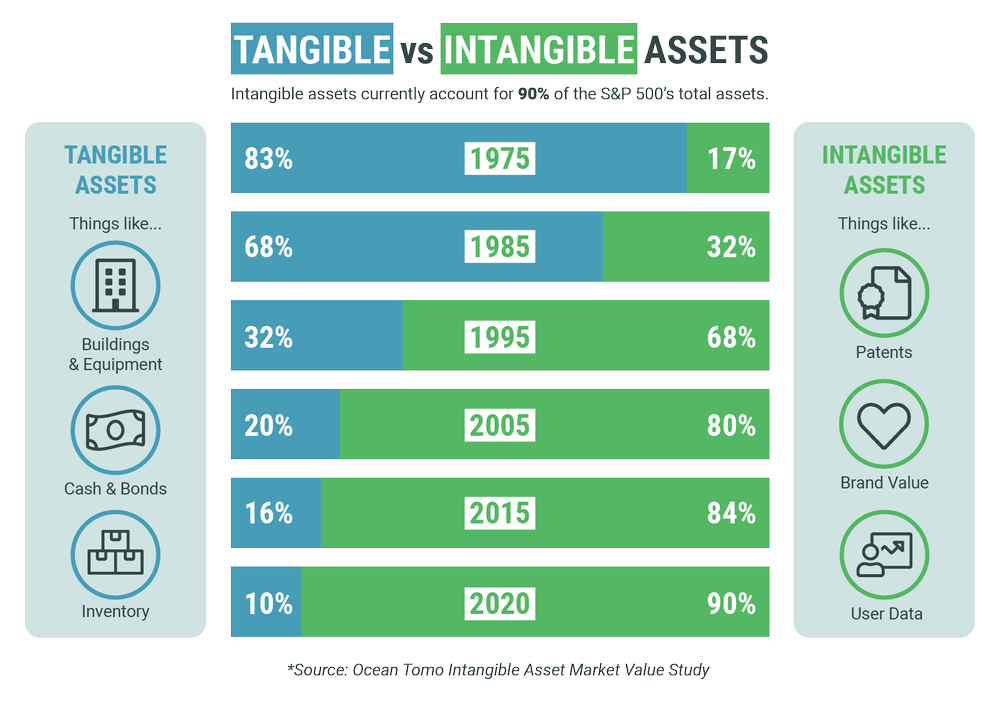
The message is clear: collaboration emerges as the pivotal strategy in an era where knowledge-sharing dominates. It’s comparable to how Kanban and Kaizan revolutionized production processes in the ’80s.
3. Remote Work Dynamics: Navigating Asynchronicity’s Double-Edged Sword
Remote employees and hybrid work models have redefined traditional workplaces. While they offer increased flexibility and potential for multi-tasking, they also pose challenges to collaboration.
The asynchronous nature of hybrid work provides more flexibility, allowing individuals and teams to multi-task more and possibly even be more productive. But this productivity can come at a social cost. With remote teams, our communication becomes much more transactional or said another way – we only connect with others when we need something from them.
This shift risks eroding the crucial elements of trust and psychological safety, which are fundamental for successful collaboration. The absence of spontaneous social connections inherent to in-person workplaces underscores the need to find innovative ways to foster these ties in remote settings.
4. Bridging The Generational Divide
For the first time, we have five distinct generations coexisting in the workforce. The accompanying chart showcases the challenges posed by this diversity. One major hurdle is the digital divide: while one generation are digital natives, having grown up with the internet, others began their careers in a pre-internet era. Addressing this divide is imperative to streamline collaboration across generational lines.
5. Countering Rising Individualism and Divisiveness
In our current society, technology has amplified individualism to an unprecedented scale. A 2019 Harris poll revealed the aspiration of “influencer” tops the career choices of American and British youth, surpassing professions like teaching and sports.
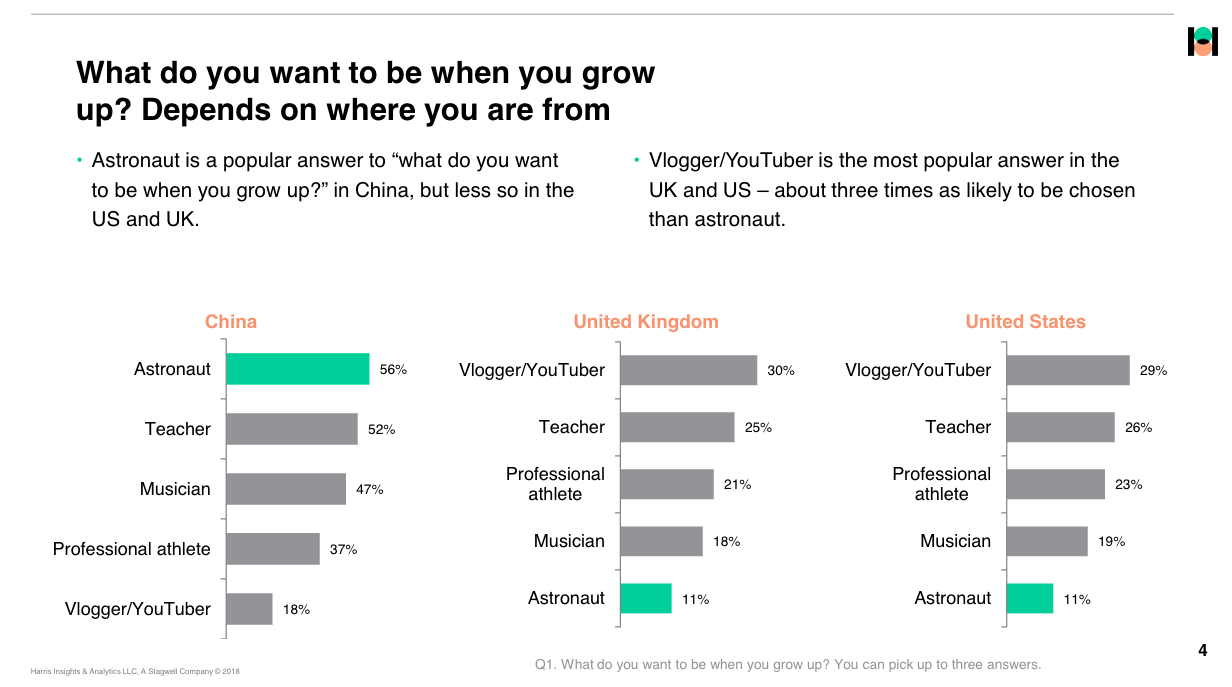
*Results of the Harris Poll survey.
This celebration of individualism and prevalent divisiveness pose a potential barrier to collaboration. As workplaces, there’s a pressing need to cultivate a culture that values collective achievements over individual accolades.

The Cascading Rewards: 3 Benefits of Workplace Collaboration
In the multifaceted ecosystem of the workplace, collaboration is the undercurrent that propels teams to generate value far beyond the sum of individual efforts. There are three foundational benefits of nurturing collaboration throughout the entire team.
1. Better, More Informed Decisions
Decisions formed through collaboration are like diamonds formed under pressure: they become multi-faceted, leading to more well-rounded and comprehensive solutions.
When minds converge to share knowledge, perspectives can intermingle, paving the way for holistic and precise decisions. By avoiding a singular viewpoint, teams can leverage diverse experiences and skills to ensure that choices are well-rounded.
2. Acceleration Of Innovation
The bridge between a good idea and a groundbreaking one is often a shared thought, an improvised solution, or a collective brainstorming session. Collaboration, in essence, becomes the petri dish where creativity meets possibility.
3. Forging a Unified Organizational Culture
It will build trust when individuals collectively tackle challenges, celebrate achievements, and learn from setbacks. A shared journey among teammates can cultivate a culture where mutual respect thrives and individuals celebrate team collaboration.
Unlocking the Power of Your Team: Six Principles of Effective Collaboration
While the significance of collaboration has become universally acknowledged, the actual blueprint for successful collaborative efforts is a mystery for some. However, after observation and experience, there are six quintessential principles that help catalyze collaborative work:
1. Valuing Diversity in Thoughts and Actions
When bound by mutual respect, diverse teams inevitably yield the most innovative solutions. Take my dynamic with my cofounder, Kirsten, as an example. She likes to gather as much input as possible, ever eager to source as many perspectives as possible. Conversely, I prioritize swift decision-making to remove barriers for my team, empowering them to progress. While these approaches might seem at odds, we both value each other’s perspective on the balance between speed and quality, usually arriving at timely and quality decisions.
2. Nurturing Openness and Curiosity For New Ideas
The term “growth mindset” has become somewhat of a catchphrase in recent years, but its essence remains pivotal. Collaboration thrives when people enter the arena with open minds, unburdened by rigid beliefs or personal agendas. Promising projects can derail because one team member can’t look beyond their preconceived notions, leaving others disenchanted.
3. Self-Awareness in The Workplace: A Collaboration Compass
Understanding your natural tendencies and those of your teammates can go a long way toward adjusting and adapting your style to the needs of the collaborative activity. Soft skills help teammates avoid common interpersonal problems, such as making assumptions about motivations or behaviors, to get the most out of one another for the best outcomes.
4. Adaptability in an Ever-Changing Landscape
The speed at which organizations, industries, and societies at large evolve is constantly increasing. These conditions make it extremely important that we know how to be adaptive, which entails performing well in the face of unpredictable and constantly changing environments.
To embrace adaptivity means comfortably pivoting when needed, responding quickly to change, and embracing the new direction. Those who can go with the flow and embrace constant change will thrive, while those who don’t will be frustrated and passed by.
For more on this, read: The Future Workplace Experience: 7 Trends Shaping A New Environment
5. Transparency: The Trust Builder
Trust is a key currency of collaboration. It is the grease that makes the gears turn. When operating in a trusting environment, we feel comfortable sharing and being vulnerable with others. We speak up, take chances, ask questions, and admit mistakes. Transparency is the fundamental building block that creates this sense of trust. If we are guarded and secretive, it allows others to make assumptions about the motivations behind our decisions.
6. Empathy and Emotional Support: Beyond the Professional Facade
We spend half of our waking hours with our colleagues. It is no surprise that these relationships are extremely important to our well-being. To assume that our non-work relationships are our only supportive systems is wishful thinking. Whether we mean to or not, we’re embedded in emotionally-involved relationships with colleagues. Teams that embrace this recognition and handle it with care will be more likely to increase the effectiveness of our collaboration.
In weaving together these principles, any organization can develop collaboration skills into a potent strategy for creating clear goals, increasing employee engagement, and improving retention.

How To Demonstrate Collaboration in the Workplace: A Guide for Leaders and Employees
How can leaders and employees move from understanding the importance of a collaborative environment to actively practicing it? This guide will provide you with actionable steps to demonstrate and encourage collaboration in the workplace.
1. Facilitate Open Communication
For Leaders: Imagine a workspace where employees aren’t just clocking hours but are passionately contributing, where every idea is valued, and every concern addressed. To shape this environment, leaders must champion a culture of inclusivity where people have a voice. This entails the opportunity for teams to discuss ideas openly and assurance that their feedback won’t result in negative consequences.
For Employees: Being part of a collaborative workspace is about more than just doing one’s job. It’s about engaging in meaningful conversations, seeking understanding when tasks are ambiguous, and valuing the perspectives of colleagues. This means taking the initiative to share insights during team meetings, asking clarifying questions when in doubt, and embracing feedback as a tool for personal growth rather than criticism.
2. Practice Active Listening
For Leaders: Envision a team meeting where every spoken word holds weight and importance. As a leader, your role is not just to advise but also to absorb. When team members share, it’s an act of trust. By leaning in, giving undivided attention, and reflecting back on their sentiments with empathy, you send a clear message: every voice matters.
For Employees: Picture yourself in a conversation where you’re hanging onto every word, not because you’re waiting for your turn to speak, but because you genuinely want to understand the narrative unfolding. This kind of listening goes beyond just hearing; it’s about immersing oneself in what others are sharing, sidelining any urge to interject.
3. Foster Diversity Within Teams
For Leaders: Diversity is an operational advantage. Drawing from varied perspectives and experiences can lead to more innovative solutions. Prioritize creating teams that reflect a broad range of backgrounds and skill sets.
For Employees: Everyone brings something unique to the table. By valuing and actively seeking insights from colleagues with different backgrounds and expertise, you better contribute to reaching team goals.
4. Share Goals & Vision
For Leaders: Outlining the company’s vision is more than setting a target—it’s about creating a clear roadmap for reaching a common goal. By openly sharing these plans, leaders can provide teams with clarity on the milestones ahead and how their roles contribute to reaching them.
For Employees: Consider your personal goals as key markers on this roadmap. By ensuring they are in sync with the team’s objectives, each task you undertake drives your progress and advances the organization’s collective mission.
5. Encourage Cross-functional Projects
For Leaders: Instead of thinking in isolated compartments, envision your organization as a network where each component strengthens the other. Initiate projects that intertwine different skills, allowing a seamless flow of ideas and expertise across the company.
For Employees: When tasked with cross-departmental projects, visualize it as an avenue for widening your knowledge and horizons. Engage with peers from different departments, absorb insights from their expertise, and fuse them with your own to enrich the project’s outcome.
6. Leverage Tools To Support Teamwork
For Leaders: Select tools that empower your teams to engage in collaborative work in real-time.
For Employees: Utilize the tools not just as a means to an end but as an intentional way to foster connections, share inspirations, and effectively communicate.
7. Recognize and Reward Collaborative Efforts
For Leaders: Move beyond generic praise. Pinpoint moments where collaboration shines brightly, and illuminate those moments with specific recognition. When teams witness their collective efforts being celebrated, it reinforces the value of the entire team in achieving success.
For Employees: When celebrated for success, always acknowledge your colleagues’ efforts. By highlighting the collective nature of accomplishments, you strengthen team unity and set the stage for more collaboration in the future.
5 Common Barriers To Effective Collaboration At Work
While collaboration stands as a pillar of productivity and innovation, it isn’t without its hurdles. Identifying barriers is the first step to ensuring seamless teamwork. By understanding the underlying causes that hinder collaboration, organizations can proactively address and overcome them.

1. Lack of Clear Communication
Barrier: Misunderstandings can stem from vague instructions, lack of feedback, or insufficient sharing of information.
Overcome: Establish regular check-ins for clarification and training on clear communication. Proactively ask questions, practice employee listening, offer feedback, and consistently document and share information with collaboration tools.
2. Mismatched Goals and Priorities
Barrier: Different teams or individuals may have conflicting objectives.
Overcome: Initiate conversations to collaboratively define mutual objectives, ensuring that all team members understand the broader organizational goals and how their tasks intersect and support one another.
3. Resistance to Change
Barrier: People can be set in their ways and resistant to new methods or tools.
Overcome: Provide workshops or training sessions to share “the why” and benefits. Create a feedback loop where team members can voice concerns and suggest improvements.
4. Lack of Trust
Barrier: A history of unresolved conflicts or competitiveness can erode trust.
Overcome: Focus on building relationships and communicating quickly. Oftentimes, confusion arises simply from a lack of understanding of each other’s unique motivations and ways of thinking.
5. Siloed Departments
Barrier: Teams or departments may become isolated, leading to a lack of collaboration.
Overcome: Encourage cross-functional projects and open-door policies to bridge gaps between departments.
True collaboration is the backbone of any thriving organization. It’s not enough to spot barriers; proactive intervention is key. Drawing on the qualities of successful collaboration not only provides a direction but also strengthens an organization’s foundation.
Remember, a unified approach not only enhances productivity but also fosters a workplace culture where every voice has the potential to drive innovation.
Conclusion: Creating a Collaborative Company Culture
Collaboration isn’t merely a buzzword for contemporary workplaces; it’s a fundamental shift in how we think, create, and grow together. As we’ve explored, the manifold benefits of collaboration — from driving innovation to fostering a united organizational culture — are crucial in today’s environment.
For leaders, the challenge is twofold: foster an environment conducive to collaboration and embody the principles of adaptive leadership. This approach, which values flexibility, responsiveness, and a willingness to learn, is the linchpin in creating a truly collaborative culture.
Forward-thinking organizations understand that maternity leave extends beyond simply accommodating one new mother; it represents a strategic opportunity to foster a supportive, inclusive culture that encourages high-performance teams. However, navigating the transition can prove challenging, even for companies with well-established maternity leave policies. As Kirsten Moorfield, COO of Cloverleaf, succinctly states, “Because people are complicated.”
As a seasoned executive and new mother who navigated three maternity leaves during my tenure as the only female vice president in a $3 billion company, I have first-hand experience with the unique professional and personal challenges this life event brings.
While mentoring women and their leaders on managing maternity leaves, I noticed distinct patterns that revealed why some teams thrive during this period while others falter. This insight inspired the creation of NestByRevel.com, a platform designed to support women in achieving career success without compromising personal well-being and quality family time.

Navigating Maternity Leave: 4 Proven Strategies The Workplace
To manage maternity leave effectively within your teams, it’s crucial to pivot your approach towards certain guiding principles. These principles, which form the backbone of successful maternity leave policies, revolve around four core strategies that contribute towards not only the smooth execution of leave but also towards building a resilient, empathetic, and adaptable workforce:
1. Team Collaboration: Foster teamwork among members to ensure smooth transition and continuity in customer service and achieve team objectives.
2. Delegation and Cross-Training: Collaborate with the expectant mother to delegate responsibilities. This approach minimizes workflow disruptions and provides growth opportunities for other team members.
3. Supportive Culture: Cultivate a flexible environment that prioritizes the well-being of new parents, while still meeting team commitments. Consider extending this flexibility to all team members.
4. Open Communication: Encourage an atmosphere where the expectant mother and the entire team can freely express their thoughts, plans, and concerns. This approach should respect boundaries and foster trust.

The Expectant Mother's Perspective: Balancing Work and New Parenthood
From the expectant mother’s viewpoint, maternity leave can be challenging. Entrusting others with your responsibilities while adapting to life with a newborn often brings feelings of insecurity and fear of being replaceable. Even well-intentioned comments from co-workers about “doing it all” or suggesting a reduced work schedule can induce self-doubt.
Cloverleaf serves as a valuable tool during this transition. It facilitates better understanding and communication among team members, promoting a sense of connection during the mother’s leave.
Daily coaching tips guide individuals in working with colleagues, identifying those needing more time for queries or others who value recognition for their efforts. Although the newborn initiates the need for this support, the entire team benefits by developing the awareness and skills needed for ongoing improvement.
Maternity Leave: A Catalyst for Growth and Success
When effectively managed, maternity leave becomes a potent catalyst for team growth and individual success. The next time a team member announces their pregnancy, celebrate this opportunity and invest in a comprehensive maternity leave program. As Melinda Gates has famously stated, “When you invest in a woman, you invest in the future.”
To learn more about Revel Coach’s programs for working mothers, visit NestByRevel.com. Utilize the code CLOVERLEAF for a 50% discount on the Maternity Leave Prep workshop.
Relevant Resources:
NestByRevel.com (Revel’s signature program for women)
Maternity Leave Prep (Link to our Maternity Leave Prep program)
RevelCoach.com (offers free Cloverleaf assessments)
I hope everyone reading this gets an opportunity for a summer break and a chance to recharge and see things from a fresh perspective.
Cloverleaf: A One-Stop-Shop For Scaling Self & Other Awareness In An Organization
Cloverleaf is an all-in-one tool that uses the most popular validated assessments to help teams understand each other better, identify individual strengths, and experience personal growth.

HUMAN SKILL PROGRAMS ARE HITTING LIMITATIONS...
- Close the widening gap between learning and on-the-job application
- Overcome the tension of pausing productivity for development opportunities
- Integrate learning so it is actually in the flow of work
- The evolution of human skill development
- What Automated Coaching™ is and how it works.
Let’s face it. We’ve all had conflicts in the workplace. Whether they are small or large, conflicts are a natural part of work and unavoidable. Even the most favorable environments will occasionally end up with team members who are at odds with one another. However, when teams view conflict with the right perspective, they can use it as an opportunity to improve communication, interpersonal relationships, and the culture of the organization.
Successful conflict management as a manager can go a long way towards realizing these benefits By understanding and implementing effective conflict resolution strategies, managers and leaders can foster a work environment that thrives on diverse perspectives and ideas without letting disagreements hamper productivity.
What is Conflict Resolution And how does it work?
Conflict resolution in the workplace is a process that two or more parties can follow to find an amicable resolution to their disagreement. The process can be formal or informal. And, keep in mind, Aas a manager, your company may have a defined conflict resolution process in place for you to implement.
In conflict resolution, every step you undertake is aimed at addressing disagreements, whether it’s between you and a direct report or among team members. Effective compromise is a hallmark of strong leadership. Successful conflict resolution can be broken down into:
- Identifying the Root Causes of the conflict
- Crafting Effective Solutions to address these causes
- Leveraging Conflict Management Tools
By gaining experience in these three domains, you’re well-equipped to navigate any disputes that arise in your professional journey. This expertise will cement your reputation as a fair mediator, adept at crafting balanced solutions for various conflict scenarios.

HUMAN SKILL PROGRAMS ARE HITTING LIMITATIONS...
- Close the widening gap between learning and on-the-job application
- Overcome the tension of pausing productivity for development opportunities
- Integrate learning so it is actually in the flow of work
- The evolution of human skill development
- What Automated Coaching™ is and how it works.
7 COMMON TRIGGERS OF CONFLICT IN THE WORKPLACE
Understanding the root causes of conflict is pivotal for people leaders when equipping managers with the tools and strategies to handle disputes adeptly. The factors influencing disagreements can range from interpersonal dynamics, age demographics, and industry-specific stressors to external personal pressures.
Here’s a deep dive into some prevalent conflict triggers, coupled with actionable insights for managers:

1. Poor Communication
Often, poor communication skills are one of the main causes of conflict. When people disagree on policies, procedures, schedules, tasks, and other details, it can easily escalate into an argument that strains relationships and decrease collaboration among teammates.
You may also see employees who have a difficult time communicating with their coworkers and may come off as aggressive or passive-aggressive. Sometimes trying to talk with one another is an exercise in frustration. If the company has inefficient or obsolete communication tools, this only adds to the stress when trying to convey information effectively.
2. Unclear Expectations
Every team member needs to understand their expectations, or their assumptions can lead to unseen conflict. Suppose two staff members have wildly different expectations about who is responsible for what, the tasks that are priorities, and the time required to do each item on the list. Varied assumptions among team members inevitably sow the seeds of conflict. Differences in perceived responsibilities, task priorities, or expected timelines can lead to issues. Regular alignment meetings, clear role definitions, and consistent feedback loops can keep everyone on the same page.
3. Unrealistic Workloads
Long stints of overtime or being in crunch mode constantly will wear people out, even high-potential employees. When employees are unable to take a long-term look at a project or the tasks they’re doing, they have to operate in the moment at all times, without a minute to catch their breaths. The burnout from project stress can create a workplace ripe for conflict. You may see that people are short-tempered, aggressive, frustrated, and have poor judgment. If you’ve reached burnout and want to heal, check out the 5 Stages Of Burnout Recovery to learn more.
4. Personality Issues
Every individual is unique, bringing their distinct personality, experiences, and aspirations to the team. Sometimes, you may observe certain personalities, such as two highly competitive team members, seemingly at odds with each other. However, the beauty of diverse teams lies in their potential to harness these differences.
On some occasions, strong personality clashes might give the impression of a challenging work environment. However, challenges present an opportunity for growth. Understanding and respecting individual preferences and aligning strategies can transform potential conflicts into avenues for teamwork and productivity.
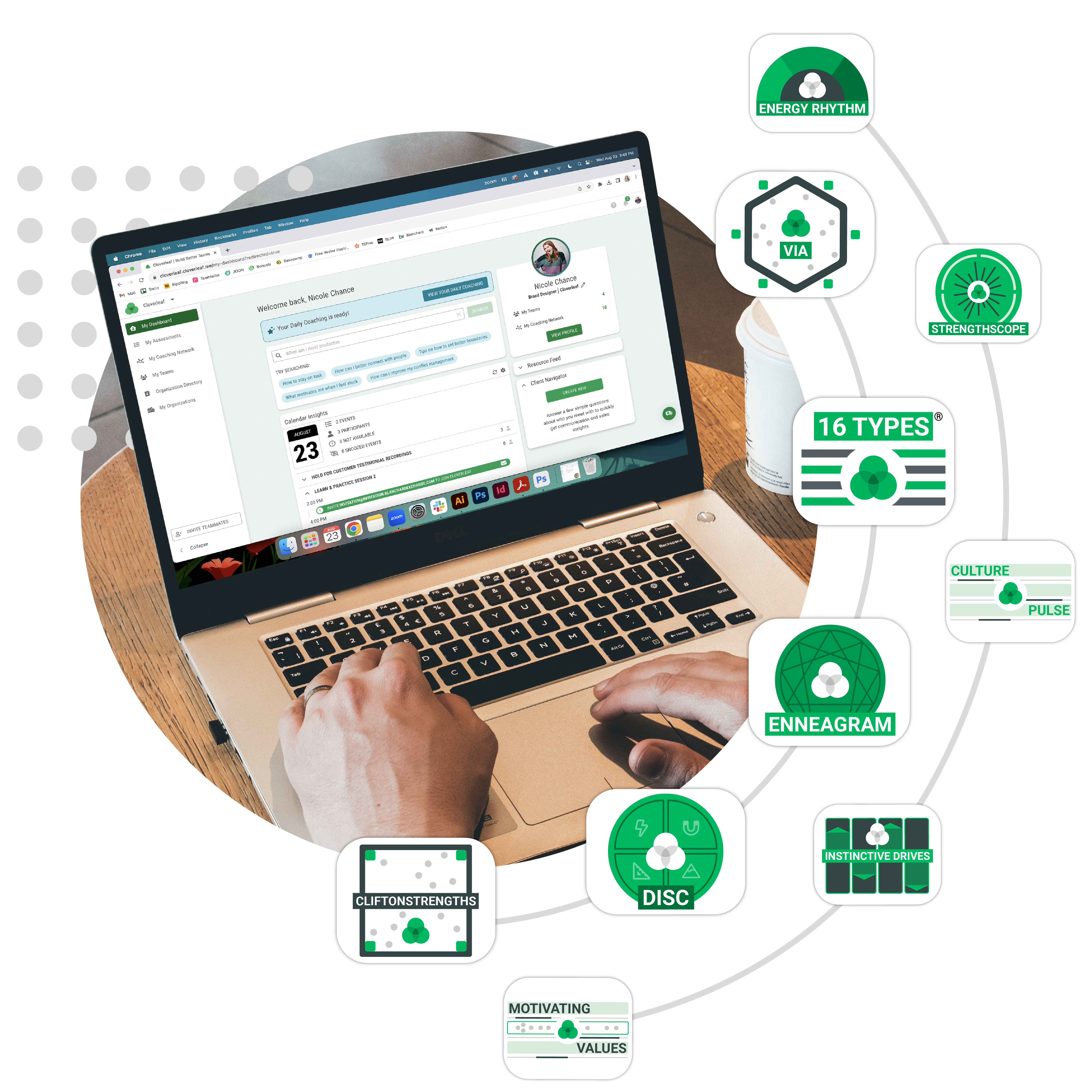
Leverage Behavioral And Strength-Based Assessments For Greater Self-Awareness In Your Organization
Tools for assessment and personal growth can be pivotal when personality issues arise. These resources can aid individuals in recognizing their areas of expertise and areas for improvement, offering insights into varied approaches to work and communication.
5. Defensive Dispositions
Some employees may take constructive criticism and other forms of feedback as a personal attack. When their work or ideas don’t get the expected reaction, they may take a defensive stance and argue about why they’re right. Managing conflict means reassuring the person that the feedback is intended to help, not hurt them. One tool that can help leaders provide customized, accurate feedback is DISC. To learn more, check out the post: Leveraging DISC Profiles For Effective Work-Related Feedback.
6. Inconsistent Procedures
How often do workflows, policies, and procedures help change your organization? If employees need to relearn how to do basic work tasks regularly, they’ll never figure out a routine that works best for their productivity. Misunderstandings about new ways of doing things can lead to conflicts without a good solution, especially if the new policies can be interpreted in different ways.
7. Concerns About The Past Work Experiences Repeating
Employees’ perspectives are not based solely on their workplace experience. People bring all of their professional and personal histories with them, which can influence how they respond to conflict. Toxic work environments, abusive coworkers and bosses, and other bad experiences can lead someone to react poorly in conflict situations. As a manager of people, understanding that your team members are whole people can help you create a workable solution for everyone involved.
By understanding these triggers and equipping managers with strategic solutions, people leaders can pave the way for a harmonious, productive, and progressive workplace.
14 Conflict Management Tips For Managers & Leaders
Successfully navigating conflicts hinges on possessing the right set of skills. As a manager or leader, having these tools in your toolkit allows you to adapt and respond aptly to diverse situations. Conflict resolution isn’t a one-size-fits-all approach. It’s a dynamic process that takes into account individual relationships, team dynamics, and the broader organizational context.
People react to conflict differently: some vent their frustrations and then move on, while others ruminate on disagreements, letting them taint future interactions and potentially fostering a passive-aggressive work environment. Employing the right management skills and solutions is crucial to addressing such issues head-on.
Below, discover the leading methods and skills to effectively resolve workplace conflicts.

1. IDENTIFY THE SOURCE OF THE CONFLICT
To effectively resolve a disagreement, it’s crucial first to understand its origin from all involved parties’ viewpoints. Grasping the underlying issues paves the way for constructive solutions and resolutions.
2. ADOPT A POSITIVE PERSPECTIVE ON CONFLICT
How you perceive conflict can greatly influence its outcome. If you see it merely as a time-consuming hurdle or an inevitable downside of teamwork, you risk escalating issues, whether through neglect or mishandling. Instead, embrace conflict as an opportunity to gain deeper insights into your team’s dynamics, needs, and reactions. It’s an avenue to bolster employee engagement and fine-tune team direction. Prioritize understanding your team’s individual work styles and motivations—doing so can provide invaluable context during conflict resolution.
To dive deeper into understanding your team’s preferences and motivations, watch how Cloverleaf can help you.
3. Practice Active Listening
Truly understanding an issue requires genuine listening. Make it a point to deeply hear out the parties involved, seeking clarity through thoughtful questions. Recognizing potential external influences or uncharacteristic behaviors can be key. Your primary role at this stage is to ensure everyone feels acknowledged. Once you’ve thoroughly gathered insights from all sides, you’ll be better equipped to formulate a conflict resolution strategy.
4. Facilitate Productive Conversations
An aspect of listening requires assuming the role of guiding a constructive conversation. Encourage individuals to articulate their experiences and feelings, as this can often unveil miscommunications or the root causes of the disagreement. Strategic questioning can further propel the discussion, steering all parties toward a mutual resolution.
5. Use Empathy
Understanding isn’t just cognitive—it’s emotional. Strive to genuinely feel the emotions and perspectives of those involved. By aligning with their sentiments and ensuring they know their feelings are recognized, you build trust and openness, which are essential for effective conflict resolution.
6. Serve As A Mediator Between Team Members
Effectively mediating conflicts between team members is a hallmark of adept leadership. Facilitating a calm and open environment where aggrieved parties can communicate is paramount. Successfully mediating helps address issues head-on, preventing them from snowballing into larger challenges.
7. Take Accountability For Your Words And Actions
Should you find yourself at the center of a conflict, taking ownership of your actions is crucial. Even unintended missteps can escalate situations; acknowledging them is the first step toward resolution. Demonstrating this level of responsibility paves the way for others to adopt a constructive approach to conflicts.
8. Be Transparent And Open
Prioritizing transparency is pivotal in conflict management. By being clear and open about your decision-making processes in resolving disputes, you can sidestep potential claims of favoritism or bias. Regularly update all involved parties about the status of the resolution, reinforcing an atmosphere of trust and understanding.
9. Genuinely Engage In The Process
Your team seeks authenticity, not a rehearsed dialogue. Address issues by tuning into the specifics of each situation and the individuals involved. Tailor your methods to acknowledge and address each individual’s unique circumstances and conflict resolution styles.
10. Frame Discussions With Objectivity
When discussing conflict, anchor conversations in facts rather than emotions. For instance, state, “Our objective is to reach a consensus on the printer’s location.” By centering on the clear end goal, you streamline the resolution process and align everyone’s focus toward a common target.
11. Incorporate Change Management Into Your Culture
Should disagreements stem from changes in workplace protocols or systems, prioritizing robust change management is key. Change management isn’t merely about implementing shifts but ensuring smooth transitions. This involves equipping employees with the necessary training, clarity about updates, and platforms to voice their feedback, ensuring they’re not just bystanders but active participants in the change.
12. Use Emotional Intelligence
Emotional awareness not only aids in understanding your team’s underlying feelings and sentiments but also gauges their satisfaction with resolutions. Furthermore, this quality enhances workplace relationships, often distinguishing effective leaders who genuinely connect with their teams.
13. Evaluate How Things Are Going
Consistently engage with the individuals involved in the conflict. Regular check-ins offer an accurate pulse on their feelings and provide an avenue to ensure conflicts remain resolved.
14. Recognize When To Make Tough Decisions
There are instances where reconciliation seems unattainable. Persistent arguments, underlying tension, or disruptive behavior can deteriorate the workplace atmosphere. In such cases, it may be necessary to consider reassigning individuals or, in extreme situations, making the difficult decision to part ways with an employee to maintain a positive work environment.

4 Step CONFLICT RESOLUTION GUIDE
Navigating conflict resolution can be challenging, especially if you’re unfamiliar with the terrain. To guide you, here’s a structured approach to mending bridges:
- Demonstrate Understanding: Make it clear that you comprehend their perspective and concerns.
- Acknowledge Your Role: Admit and recognize your contribution to the disagreement.
- Express a Desire for Resolution: Emphasize your commitment to finding common ground and resolving the issue together.
- Revisit the Conversation: If immediate resolution isn’t achieved, give it some time and approach the topic again later.
7 Proactive Strategies To Prevent Conflict In The Workplace
While addressing and resolving conflicts is crucial, proactively preventing them can lead to a more harmonious and productive workplace. Instead of merely firefighting, the key lies in fostering an environment where potential conflicts are nipped in the bud. By equipping your workspace with the right tools, training, and resources, managers can pave the way for smoother interpersonal relationships and minimize disruptions.
1. Utilize Communication Channels:
Efficient communication is paramount. Embrace tools that facilitate open communication, whether they’re software-based, like emails, chat applications, or video conferencing.
Explore the Cloverleaf integrations with everyday tools. Find out more here.
2. Prioritize Availability
Reflect on your daily schedule. Is there a dedicated window where team members can reach out to you directly about potential issues? Ensure a consistent open discussion slot, signaling your team that their concerns are valued.
3. Proactively Address Pending Conflict
With the right systems for conflict resolution in place, preemptively identify and address budding tensions. Recognizing early signs of discomfort can drastically reduce the negative impact on the team’s dynamics.
4. Prioritize Team Engagement
Regular team interactions can cultivate stronger bonds, whether through meetings or casual team lunches. Creating spaces for open dialogue often defuses tensions before they escalate.
5. Champion Fairness
Favoritism can erode trust. Ensure you treat every team member equitably, fostering an environment of mutual respect. For more on this, check out the post: How To Address Unconscious Bias In The Workplace.
6. Address The Elephant In The Room: Avoiding issues only leads to mounting tensions. Address the proverbial “elephant in the room” head-on, ensuring issues are dealt with transparently and reinforcing your credibility as a leader.
7. Leverage External Insights And Coaching
Sometimes, an outside perspective can offer invaluable insights into internal conflicts. Consider integrating third-party coaching services, like Cloverleaf, which combines personalized coaching with data-driven analytics, offering a comprehensive solution for conflict resolution.
How Does Cloverleaf Help?
If left unchecked, team conflicts can precipitate a cascade of challenges within an organization. Effective conflict management, therefore, isn’t just a responsibility—it’s an imperative for managers. Enter Cloverleaf, a dynamic solution tailored to preempt, navigate, and resolve conflicts, fostering healthier team interactions and stronger organizational dynamics.
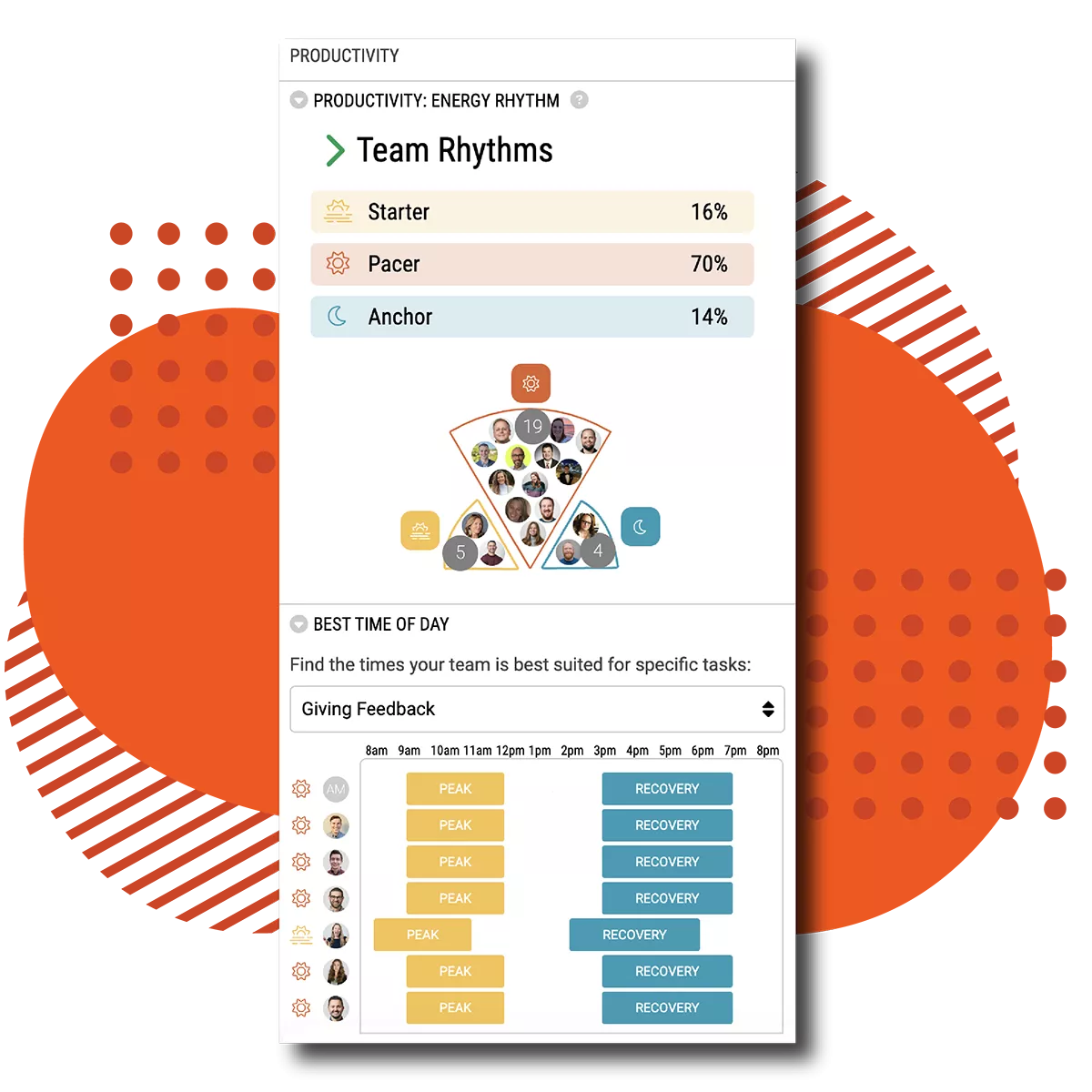
Core Conflict Management Solutions Delivered by Cloverleaf:
1. Anticipating Team Friction: Instead of reacting to conflicts, Cloverleaf enables proactive measures by helping you understand the sources of conflict for every person on your team.
2. Navigating Internal Blind Spots: When internal tensions rise, seeing the overarching issues is challenging. Cloverleaf offers an external lens, bringing clarity and solutions that might be missed from an inside viewpoint.
3. Bespoke Conflict Strategies for Unique Teams: Every team is distinct, and cookie-cutter solutions often fall short. Cloverleaf customizes its approach by merging assessment data and conflict resolution coaching, ensuring that strategies resonate with your organization’s specific needs.
4. Unearthing Deep-Rooted Conflict Triggers: Addressing surface-level issues without understanding the root causes is akin to applying a band-aid on a deep wound. Cloverleaf dives deep to unearth the real reasons behind conflicts, ensuring sustainable resolutions.
5. Skill Enhancement for Modern Managers: Beyond just resolving the current conflict, Cloverleaf’s Automated Coaching™ provides actionable insights, preparing managers for future challenges, enhancing communication, and fostering a culture of continuous learning and improvement.
6. Transforming the Narrative on Conflict: Instead of being seen as roadblocks, conflicts can be growth catalysts. Cloverleaf repositions the perception of conflict, making managers not just problem solvers but also enablers of team evolution and personal growth.
Final Thoughts
Effective conflict management is about addressing disputes and fostering a proactive, transparent, and emotionally intelligent workplace culture. With tools like Cloverleaf, organizations are empowered to navigate conflicts and prevent them, ensuring teams remain cohesive, productive, and harmonious. As managers and leaders, embracing both preventive and corrective strategies ensures a dynamic, engaged, and resilient team capable of driving unparalleled success in any industry.
In today’s dynamic work environment, marked by globally dispersed teams and remote collaboration, self-awareness has transformed from a psychological concept into a business imperative. It’s no longer just about personal well-being or mental health; it directly impacts productivity, job satisfaction, and the organization’s bottom line.
Leaders in organizations set the tone for modeling self-knowledge. Their ability to understand their emotions, biases, strengths, and weaknesses and how these aspects affect their interactions and decision-making processes is critical.
What Is Self-Awareness In The Workplace?
Self-awareness in the workplace is about tuning into your emotions, strengths, and behaviors and understanding their impact on others. It’s a practical skill that boosts communication, decision-making, and teamwork. Knowing your values and behavioral patterns can help contribute to a more effective, collaborative, and positive work environment.
A high level of self-awareness allows leaders to be authentic, which, in turn, fosters trust within teams. A leader who is genuine, unafraid to admit mistakes, and humble enough to leverage the team’s collective strengths is likely to create an environment of openness and collaboration.
This sense of authenticity inspires reciprocity. When a leader is authentic, team members feel more comfortable being authentic.
What about individual contributors, though? The role of self-understanding doesn’t diminish when we shift our focus from individual contributors might argue it becomes even more crucial. Self-awareness in these roles equates to understanding one’s own strengths and weaknesses, recognizing triggers, and being aware of the effects one’s actions can have on the work environment.
Key Takeaways:
- Self-awareness has evolved into a business imperative that influences productivity, job satisfaction, and the bottom line, transcending its psychological roots.
- Leaders play a pivotal role in fostering self-awareness, setting the tone for organizational culture and employee engagement by embodying self-knowledge and authenticity.
- Assessments and tools can help foster self-awareness in the workplace, enhancing understanding of individual strengths, weaknesses, and work styles.
- The cultivation of self-awareness at all levels of an organization can enhance individual performance, agile leadership, and, ultimately, the organization’s bottom line.
Just like someone using GPS to navigate, being self and others aware at work helps individuals steer through professional interactions without getting ‘lost.’
Being mindful goes beyond the self—it involves understanding the perspectives of others, being aware of the team’s collective strengths, and recognizing the different mindsets of co-workers.
When emotional intelligence becomes part of the company culture, it can transform all employees’ work-life balance, well-being, and satisfaction. But, the road to cultivating self-awareness isn’t always smooth.

4 Challenges to Self-Awareness in the Workplace
Promoting self-awareness can be a complex process. One such challenge lies in the cultural fabric of the organization itself. An organization’s culture can either nourish personal growth or squash it.
A culture promoting learning and openness encourages employees to understand their personal strengths, recognize their weaknesses, and work on their professional development. Such a culture facilitates employees to be more conscious of their own actions and behavior to create stronger relationships within the team.
Leaders who want to promote self-understanding within an organization often face hurdles. These roadblocks can hinder the growth of individuals if the culture is adverse to change.
To navigate these challenges, it is essential to understand and acknowledge them first:
1. Organization Culture: An environment that encourages silos and secrecy will hinder self-reflection. It inhibits the open exchange of ideas and feedback, which is essential for personal growth.
2. Unconscious Biases: These biases can color our perception of ourselves and others, thus skewing our understanding and preventing us from gaining a clear self-view.
3. Ego: Egos can often act as a barrier. They can prevent us from acknowledging our own emotions or shortcomings and accepting our areas of improvement.
4. Fear of Feedback: The fear of negative feedback or criticism can keep us from seeking the valuable insights we need for growth.
The role of leadership is pivotal in the process of promoting self-awareness. According to Gallup®, managers account for up to 70% of the variance in employee engagement.
Without leaders understanding their behavior and its impact on culture and business outcomes, the organization can become chaotic. A leader’s awareness helps set the stage for organizational health and an engaging employee experience.

HUMAN SKILL PROGRAMS ARE HITTING LIMITATIONS...
- Close the widening gap between learning and on-the-job application
- Overcome the tension of pausing productivity for development opportunities
- Integrate learning so it is actually in the flow of work
- The evolution of human skill development
- What Automated Coaching™ is and how it works.

How To Ignite Self-Awareness In Employees
Promoting self-awareness in a corporate setting can seem like a daunting task. It always helps when an individual has an intrinsic motivation to elevate their emotional intelligence in the workplace.
In the book The Leadership Challenge, authors Kouzes, and Posner studied leadership across industries and cultures and identified five practices of exemplary leadership. The first practice is to “Model the Way.”
Great leaders promote self-awareness by exhibiting it. Organizations offer learning and development opportunities, career pathing, and an internal standard of being an effective leader in this workplace.
Let’s break this down and explore specific strategies that both leaders and individual contributors can adopt to foster self-awareness:
3 Tips For Leaders:
- Seek Feedback Regularly: Leaders should actively solicit feedback from their teams. This can help them understand how their actions and decisions are perceived, providing valuable insights for self-improvement.
- Practice Mindfulness: Being mindful and present in every interaction allows leaders to observe their behavior and its impact on others more effectively.
- Self-evaluation: Regular self-assessment can help identify areas of strength and improvement, contributing to a deeper understanding of oneself.
3 Tips For Individual Contributors:
- Seek Mentorship: A mentor can provide an external perspective, helping individuals better understand their strengths and weaknesses.
- Practice Active Listening: By understanding others’ perspectives, individuals can cultivate empathy and increase their awareness of others’ experiences and needs.
- Cultivate Empathy: Developing empathy can enhance understanding of others, promoting better teamwork and collaboration.
Everyone within the organization should be given opportunities to develop self-awareness skills. Leaders can facilitate this growth by empowering and supporting each team member. After all, a self-aware team can contribute significantly to a positive working environment, enhance collaboration, and ultimately drive organizational success.
How Can Self Awareness Be Applied In The Workplace?
Applying self-awareness in the workplace involves regularly reflecting on personal emotions, strengths, and behaviors and understanding their impact on team dynamics and decision-making. It’s about actively seeking feedback, being open to learning, and adjusting behaviors for better collaboration and communication.
Leaders can encourage self-awareness by creating an environment of trust and openness where employees feel safe to express themselves and learn from their experiences. This approach leads to a more empathetic, cohesive, and effective workplace, where everyone knows their contributions and impact on the team and organizational goals.
10 Ways To Apply Self-Awareness At Work
1. Tailor Communication: Use your self-awareness to adapt how you communicate. If you know you’re a direct communicator, you might soften your approach when dealing with more sensitive topics or colleagues who prefer a gentler communication style.
2. Manage Reactions: Knowing your triggers, you can better control your reactions. For instance, if tight deadlines stress you out, you can plan or communicate your concerns early.
3. Play to Your Strengths: Recognize what you’re good at and volunteer for tasks that align with your strengths. This not only boosts your confidence but also increases your efficiency and effectiveness.
4. Acknowledge Weaknesses in Team Settings: Openly acknowledge areas you’re working on in team discussions. This honesty fosters trust and encourages others to share, creating a supportive team environment.
5. Adjust to Others’ Work Styles: Understanding your preferences can help you better adapt to others’ styles. For example, you might compromise with a quick call if you prefer email, but a colleague likes face-to-face meetings.
6. Enhance Decision-Making: Use self-awareness to recognize biases in your decision-making process. This can help you make more balanced and fair decisions.
7. Set Realistic Goals: Knowing your capabilities helps set achievable goals. This avoids overcommitment and under-delivery, leading to more consistent performance.
8. Improve Conflict Resolution: Understanding your conflict style – whether you tend to avoid, want a competitive edge, or find ways to mediate – can help you navigate disagreements more effectively.
9. Seek Roles That Suit You: Use your self-awareness to guide your career path. Choose roles that align with your values, interests, and skills.
10. Foster a Positive Work Environment: By being aware of your mood and its impact on others, you can contribute to a positive, energizing work culture.

Leveraging Assessments And Tools For Greater Self-Awareness In The Workplace
Assessments and personal development tools play an indispensable role in fostering self-awareness in the workplace. These resources help individuals identify their strengths and weaknesses and provide insights into diverse work and communication styles.
Top Personality Tests For Employees
Utilizing personality assessments can help employees better understand their working styles, strengths, and areas for improvement to foster collaboration within the team. Here are the top five assessments that can significantly enhance performance in the workplace:
16 Types (MBTI): This tool helps identify personality types based on four dichotomies: Extraversion-Introversion, Sensing-Intuition, Thinking-Feeling, and Judging-Perceiving. Understanding these aspects can help individuals recognize their preferences in perceiving the world and making decisions.
DISC: DISC measures an individual’s Dominance, Influence, Steadiness, and Conscientiousness, helping teams understand their dynamic better and enabling more effective communication, feedback, and collaboration.
Enneagram: The Enneagram personality test identifies individuals’ basic fears and desires, helping them understand their motivations and behaviors better.
CliftonStrengths®: This assessment helps individuals identify their top talents, allowing them to leverage these strengths for better performance and satisfaction at work.
VIA: Character Strengths: The VIA survey helps individuals identify their dominant character strengths.

Leveraging Assessments And Tools For Greater Self-Awareness In The Workplace
Assessments and personal development tools play an indispensable role in fostering self-awareness in the workplace. These resources help individuals identify their strengths and weaknesses and provide insights into diverse work and communication styles.
Top Personality Tests For Employees
Utilizing personality assessments can help employees better understand their working styles, strengths, and areas for improvement to foster collaboration within the team. Here are the top five assessments that can significantly enhance performance in the workplace:
16 Types (MBTI): This tool helps identify personality types based on four dichotomies: Extraversion-Introversion, Sensing-Intuition, Thinking-Feeling, and Judging-Perceiving. Understanding these aspects can help individuals recognize their preferences in perceiving the world and making decisions.
DISC: DISC measures an individual’s Dominance, Influence, Steadiness, and Conscientiousness, helping teams understand their dynamic better and enabling more effective communication, feedback, and collaboration.
Enneagram: The Enneagram personality test identifies individuals’ basic fears and desires, helping them understand their motivations and behaviors better.
CliftonStrengths®: This assessment helps individuals identify their top talents, allowing them to leverage these strengths for better performance and satisfaction at work.
VIA: Character Strengths: The VIA survey helps individuals identify their dominant character strengths.
Cloverleaf: A One-Stop-Shop For Scaling Self & Other Awareness In An Organization
Cloverleaf is an all-in-one tool that uses the most popular and validated assessments to help teams understand each other better, identify individual strengths, and experience personal growth.
Cloverleaf’s user-friendly dashboard offers insights into side-by-side assessment comparisons, strengths and blindspots, and team dynamics all in one place.
Teams using Cloverleaf have reported significant improvements: a 41% increase in strength awareness, a 24% increase in psychological safety, and a 33% increase in feeling recognized.
Empower your people to understand each other, give feedback, be heard, lead effectively, and love working together. Start a free team trial today!
4 Ways Self-Awareness Can Lead To Greater Organizational Effectiveness
The benefits of self-awareness extend far beyond knowing one’s strengths and weaknesses. It’s a vital ingredient that fuels numerous aspects of professional success.
1. Improved Decision-Making: Self-aware individuals have a clearer understanding of their values, principles, and goals, leading to better decisions. They’re less likely to be swayed by external factors and can make choices aligned with their core beliefs.
2. Enhanced Leadership Skills: Self-aware leaders can identify their strengths and shortcomings and adapt their leadership styles accordingly. They are more likely to lead by example, foster open communication, and create an inclusive environment, all of which contribute to a positive organizational culture.
3. Increased Job Satisfaction: Self-awareness enables individuals to understand what motivates them and their skill sets. Leaders can help tailor their career paths to their aspirations and abilities.
4. Better Mental Health: Self-awareness aids in recognizing and managing emotions, reducing stress, and maintaining mental well-being. It’s a powerful tool for resilience, enabling individuals to better cope with challenges and setbacks.

The Impact of Self-Awareness on Organizational Success
Research points to a clear correlation between self-awareness and performance. Notably, Bass & Yammarino and Atwater & Yammarino’s studies highlight how individuals with a more accurate perception of their abilities typically perform better.
The utility of self-understanding extends to leadership as well. A study conducted with the Royal Navy found that leaders with a higher self-awareness could adapt their leadership style to situational demands more effectively, demonstrating the essence of agile leadership.
The implications of these findings are clear. When organizations foster self-awareness at every level, they witness individual performance and leadership agility improvements, ultimately enhancing their bottom line. This highlights the transformative potential of self-awareness when it becomes an integral part of daily practices, shaping individuals and organizations toward success.
These examples demonstrate the transformative power of self-aware people in diverse professional contexts. They show that self-awareness is a personal attribute and a vital skill that fuels collective growth and success.
Source: themyersbriggs.com
Adopting self-awareness is not a one-time task but a journey that needs to be integrated into daily routines. Implementing tools that provide automated, personalized coaching can be a valuable aid. By offering daily insights about oneself and one’s teammates, these tools help in nurturing self-awareness as a habit.
Self-Awareness: The Catalyst for Organizational Transformation
When individuals strengthen self-awareness, the collective team is elevated, directly impacting business results.
Connect with us today to explore the power of self-awareness and unlock your team’s full potential. Stay updated with the latest insights for creating a healthy workspace by following us on LinkedIn and other social media platforms.
Self-awareness is not a buzzword; it’s a transformative tool that shapes individuals, teams, and organizational culture. Here’s to making it an integral part of our professional lives.
Receiving feedback in the workplace is often perceived as walking on eggshells. This process demands high emotional intelligence, communication skills, and an open mind.
Feedback in the workplace is an essential component of professional development and performance management. However, the art of giving and receiving feedback is often misunderstood and can cause tension if not done in the right way.
Here’s where the DISC profile can be highly beneficial. Using DISC when giving or receiving feedback could transform this entire process. Understanding the nuances of DISC can help leaders turn the process from a source of dread into a powerful catalyst for personal and professional growth.
Key Takeaways:
- Understanding an individual’s DISC type can transform the feedback process from a stressful task into a catalyst for growth.
- Feedback strategies can be personalized based on the DISC type of each team member.
- Using DISC profiles in feedback enhances communication, builds empathy, strengthens team unity, and promotes professional growth.
- Leaders are pivotal in integrating DISC profiles into their team’s feedback culture.

DISC Can Simplify Feedback With Behavioral Insights
The DISC profile is a behavioral assessment tool that helps individuals identify their blind spots in communication. It categorizes individuals into four types:
- Dominance (D)
- Influence (I)
- Steadiness (S)
- Conscientiousness (C)
Each type responds differently to feedback, making it a key point in giving effective feedback.
Understanding DISC is one thing, but applying it in a team setting is another ball game. As Learning and Development Leaders, it’s crucial that you not only understand the DISC profile yourself but also effectively train your team members in it.
Start with a clear, simple introduction to DISC and its benefits. Make sure to articulate how understanding one’s DISC profile can help individual teammates enhance their communication skills and excel in their roles. Emphasize the relevance of DISC to real-life situations within your team’s specific workplace context.
To help you get started, visit our post: A Leaders Guide To Using DISC In The Workplace!
Once your team is familiar with the basic concept of DISC, move on to conducting DISC assessments. This process should be framed as a positive opportunity for self-awareness and professional development rather than a test or evaluation.
Take our free DISC assessment to gain actionable insights concerning your results and start receiving Automated Coaching™ to help your team perform more effectively.
Properly introducing DISC to your team and guiding them in its application can lead to more effective feedback sessions and foster an environment conducive to growth and learning. The art of giving and receiving feedback becomes a collaborative effort, raising the level of communication and understanding within the team.

HUMAN SKILL PROGRAMS ARE HITTING LIMITATIONS...
- Close the widening gap between learning and on-the-job application
- Overcome the tension of pausing productivity for development opportunities
- Integrate learning so it is actually in the flow of work
- The evolution of human skill development
- What Automated Coaching™ is and how it works.

How DISC Can Transform Your Teams Feedback Processes
The DISC profile is not just a personality test; it’s a critical tool for enhancing communication skills and improving the feedback process. By tailoring your feedback to an individual’s DISC type, you align your communication style with their preferences, leading to more useful feedback and performance improvement.
For example, consider a scenario where a manager gives lengthy, detail-oriented feedback to an ‘I’ type employee, unaware of DISC principles. This type of feedback, incompatible with their enthusiastic and big-picture communication style, may make the feedback session unproductive, a pitfall that could be avoided using DISC profile insights.
The Pivotal Role of Leadership in Shaping a DISC-Enhanced Feedback Culture
Within this context, the role of people development becomes critical. Leaders need to understand and apply DISC principles and cultivate a feedback culture within their teams where DISC becomes integral.
4 Ways To Use DISC To Support A Feeback Culture
1. Strategize Feedback Sessions with Mixed-DISC-Type Teams
This involves leaders becoming adept at identifying the DISC profile of each person and tailoring their feedback accordingly. For example, if a leader is providing feedback to an individual who falls under the ‘D’ category (Dominance), they may opt for a more direct, concise approach focusing on solutions rather than dwelling on problems.
In contrast, when dealing with an ‘S’ type (Steadiness), the leader might need to be more patient and supportive, providing feedback with more warmth. This approach makes feedback a personalized tool that resonates more effectively with each person, promoting meaningful performance conversations.
2. Navigate Conflict Resolution Using DISC
Leaders can leverage DISC insights to navigate and mediate conflicts among teammates more effectively. For example, if a conflict arises between a ‘D’ type (who tends to be competitive and assertive) and an ‘I’ type (who prefers a more collaborative and harmonious environment), the leader can use their understanding of these profiles to guide the conversation.
They can respect the ‘D’ type’s need for directness and results while emphasizing the ‘I’ type’s importance of positivity and cooperation. By doing so, leaders can ensure that conflicts become opportunities for learning and growth rather than sources of division.
3. Promote DISC Understanding for Professional Development
Encouraging your team to understand their DISC profiles is integral to fostering a healthy feedback culture. By hosting DISC workshops or sharing resources for self-study, leaders can ensure that everyone understands their communication styles and how they interact with others.
This understanding not only fosters empathy and strengthens team cohesion but also aids in personal development in the workplace by highlighting areas for improvement.
For example, an ‘I’ type individual might realize they need to focus more on details, or a ‘C’ type might work on becoming more open to change. As each person strives for improvement, the team as a whole becomes stronger and more efficient.
This transition requires an open mind and a commitment to using DISC regularly, but the rewards for team performance and cohesion are well worth the effort.
4. Leverage Cloverleaf’s Side-By-Side Thinking Comparison Tool
Utilizing the power of Cloverleaf’s Thinking Comparison tool gives teammates unique insight into their colleagues’ diverse thinking styles and motivational drivers, all through the lens of DISC profiles.

Practical Tips and Strategies for Each DISC Type
Explore our comprehensive guide filled with nuanced strategies for each DISC profile. Each section, illustrated with practical scenarios, provides valuable insight on how to optimize feedback delivery and reception to foster growth and efficient communication.
D Types: The Power of Directness and Efficiency
D types value directness, efficiency, and tangible results, which can feel challenging when giving feedback. However, understanding their communication style and preferences can transform this process into a productive, stress-free experience.
Below are several ways leaders can adapt their approach to communicate with D types effectively:
- Adopt a Direct Approach: D types appreciate straight talk. Discuss the current situation, desired outcomes, and actionable steps to achieve these goals. For instance, if you’re giving feedback to a ‘D’ type salesperson falling behind their quota, emphasize the key points succinctly and directly.
Emphasize Results: D types are results-oriented. When discussing their performance, focus on concrete data and facts rather than emotions or personal opinions. This helps them understand their standing and motivates them to improve.
Promote Independence: Give D types as much independence as possible to achieve their desired outcomes. Respect their abilities and encourage them to devise an action plan, harnessing their pioneering spirit.
Maintain Clarity: D types appreciate clearly defined boundaries, time limits, and resources. Clarity helps them operate efficiently and productively.
Prepare for Energy: It’s common for D types to respond with high energy. Don’t be overwhelmed. Stay strong, clear, and calm, offering respectful feedback that empowers them towards improvement.
I Types: Engaging with Enthusiasm and Creativity
Individuals with an ‘I’ profile are known for their enthusiasm, creativity, and sociability. They thrive when feedback is positive and engaging. Understanding how to navigate their preferences can lead to highly productive interactions. Let’s dive into strategies that make feedback more effective for I types:
- Express Positivity: I types appreciate an optimistic approach. When discussing performance issues, highlight the benefits of the desired outcomes and demonstrate confidence in their abilities to meet these goals. For instance, if an ‘I’ type graphic designer’s creations don’t align with the company’s brand image, offer constructive feedback with an emphasis on positivity.
Focus on the Big Picture: I types are big-picture thinkers who appreciate understanding the broader impact of their work. Make sure to connect individual tasks and performance outcomes to the larger team or organizational goals.
Encourage Creativity: Acknowledge their creative abilities and interpersonal skills. I types tend to be innovative and social, so recognizing these traits can help in fostering a positive feedback environment.
Maintain Engagement: Keep the conversation lively and engaging, as I types prefer interactive discussions. However, be prepared to steer the conversation back on track if they start to wander off-topic.
Ensure a Positive Tone: I types respond better to a firm, measured, and positive tone. They’re likely to be more receptive to your feedback if you can deliver it in an upbeat manner.
Set a Clear Timeline: To ensure understanding and accountability, close by agreeing on a timeline for implementing the suggested improvements. This will help ‘I’ types focus their energy and creativity on meeting their performance goals.
S TYPES: Emphasizing Support and Collaboration
- Embrace Patience and Reassurance: S types thrive in situations where they feel reassured and supported. While discussing areas of improvement, do so patiently, ensuring they understand you are critiquing the performance, not the person.
Highlight Their Strengths and Progress: Along with pointing out areas for improvement, acknowledge their strengths and progress, no matter how small. This balanced approach encourages S types and reinforces their sense of value.
Clarity on Expectations: Be clear about your expectations from S types. Ambiguity can create stress for them, so maintain clear, direct communication about goals and performance standards.
Create a Step-by-Step Plan: Guidance can greatly aid S types. Construct a step-by-step improvement plan together, providing them with a clear path to enhancing their performance.
Regular Check-Ins: Conducting regular feedback sessions helps S types feel secure and valued. Regular check-ins demonstrate your commitment to their development and allow for timely recognition of gradual improvements in their performance.
C TYPES: Precision, Accuracy, and Logical Thinking
Engaging in feedback sessions with C types, known for their conscientiousness, logical thinking, and accuracy, can be greatly enhanced by understanding their preferences. Below are some key strategies that will make your feedback sessions with C types more effective and productive:
- Precision is Key: C types value precise, specific feedback. If you’re discussing a ‘C’ type accountant’s errors in financial reports, make sure your feedback pinpoints the exact mistakes, elucidates their impact, and provides clear guidelines for correction.
Emphasize Facts and Details: Stick to a factual discussion focusing on the current results and the necessary improvements. Provide evidence or examples when necessary, as C types appreciate the meticulous analysis of situations.
Allow Time for Planning: After providing your feedback, give them time to process the information and develop a plan for achieving the desired outcomes. They prefer to take time to think things through.
Establish Clear Deadlines: Agree on a specific time frame for performance improvement, including a final deadline and milestones for reviewing progress. Firm deadlines give them a clear goal to work towards and ensure accountability.
Recognize their Competence: Whether in private or through email, recognize their hard work, precision, or competence. Positive reinforcement goes a long way in motivating C types to continuously improve.

Mastering the Art of Receiving Feedback Using DISC
Receiving feedback constructively requires self-awareness of your own DISC type. Understanding your communication preferences can help you interpret feedback from a new perspective and take action accordingly. This understanding fosters an environment of regular and real-time feedback, aiding in personal development.

Conclusion
Understanding and applying DISC profiles in the workplace can revolutionize the feedback process, transforming it from a potential point of conflict to a tool for growth and improvement. Remember to share feedback regularly and always maintain the right way of communication according to the DISC type.
Leveraging platforms like Cloverleaf can help you foster better understanding and synergy in your team’s interactions, accelerating conflict resolution and fostering a stronger, more cohesive unit.
Visibility into the communication styles, work approaches, and intentions of colleagues can significantly bolster team cohesion, and improve collaboration, impacting organizational effectiveness.
Schedule a meeting today to learn how Cloverleaf can help you develop the leaders who manage teams.
With more collaborative company cultures, and more technology to help get the job done – the way we collaborate on teams is changing. While many people still have hesitancies surrounding the sometimes ineffectiveness and risk of teamwork, a HBR article explains the only way to combat this hesitancy is by “gaining firsthand experience with one or more collaborative projects.”
Once people understand the value of collaboration, they can begin to improve how they collaborate with others. We’re lucky that we are in an age where we can use tools to help make collaboration easier, more effective, and more enjoyable. Below are a list of must-have tools for collaboration in the workplace and new tools that are changing the way we collaborate.
Must-HaveTools For Team Collaboration

For teams with remote members, or that team member who is stuck at home from a “random ice blizzard” for the 10th time this month, you can still have engaging meetings that work the same as if you were all in the office. Zoom is a video conference platform that allows you to easily communicate with people across different locations. You can easily share screens with participants and co-annotate to allow for interactions between everyone.
A platform that can’t be forgotten when talking about online collaboration tools. From sharing documents on google drive to Gmail and Calendar, this cloud based collaboration tool allows people to easily work on projects together. From high school project to a company’s RFP document, everyone can benefit from the features of G Suite. Need a way to organize and centralize your tools including G Suite? Check out Happeo!

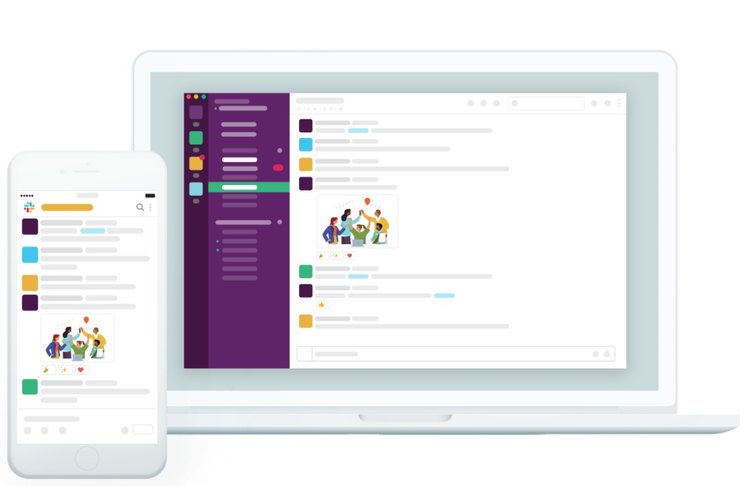
You are sitting at your desk and realize that you need some ideas on a hilarious joke you are going to tell in the next podcast. This is obviously a really important task that you want your team to help you on but probably not too time sensitive. Best way to handle this – put it in the #random Slack channel. Maybe even attach your google docs file in the message so that everyone can truly understand your goals for the podcast. With organized conversations and a variety of integrations, Slack has become a must-have collaboration tool for fast-moving teams.
The way team members work together to collaborate can always be improved. For this reason, feedback is critical. Through continuous performance management, 15Five helps to increase employee performance, engagement, and the ability to improve collaboration with one another.
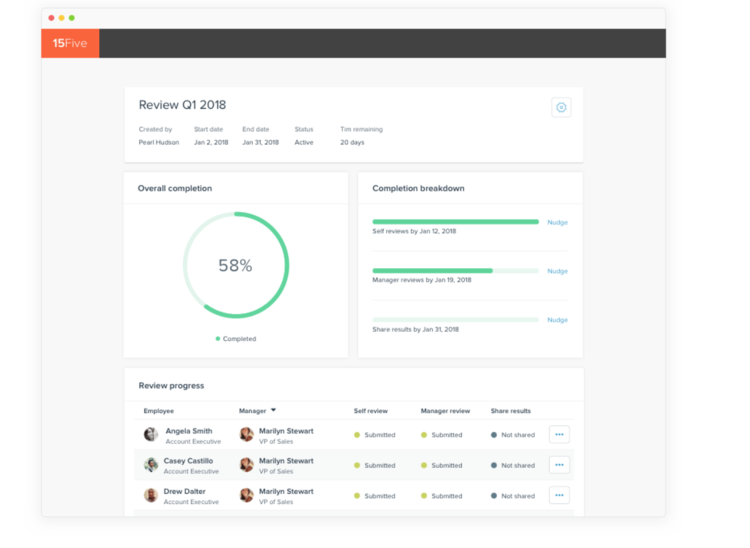

Meeting goals are kind of important. Asana is a platform which helps teams to map out projects, visualize the progress, and ensure a project is set to be met on time. Oh and, of course, Asana integrates with our most important tools like Slack and G Suite.
Tools changing the way we collaborate
We all want to improve the way we collaborate as a team. While the five collaboration tools above cover the bases, these five tools below are changing the way we think about team collaboration so that every team can be more effective, efficient, and equipped to succeed.
Probably the best invention since sliced bread (we are probably a bit biased). Cloverleaf cross-maps your team’s personality, skills, and culture, and reveals insights that can help you make better decisions about your teams. By understanding more about your team members, you can know how best to work with them and collaborate effectively as a team.


Sharing what you are working on with your team can have multiple benefits. Not only is everyone on the same page and motivated by understanding the strategy for how a goal is being accomplished, but by knowing what others are working can decrease inefficiencies in any overlap of work. Another exciting perk is that it becomes even easier to celebrate team success and recognize individuals. Who doesn’t enjoy a bit of celebration that encourages team collaboration?!
In group settings, we all have biases that can negatively impact how we work on a team. Balloonr is a platform that helps to gather anonymous ideas and feedback and then collaborate with them. Through Balloonr your team can collaborate more effectively by avoiding group dynamics, cognitive biases and fear of failure which can all result in time wasted, poor decisions and lack of innovation.

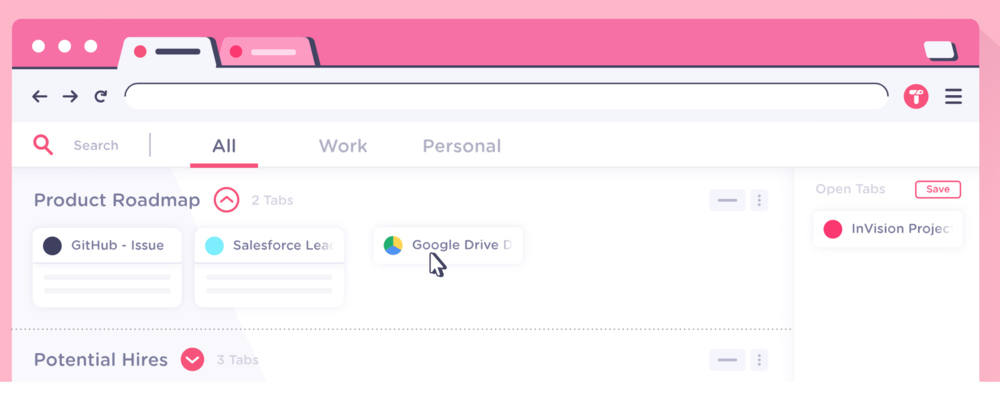
In today’s cloud based world, we all may have too many tabs open to count as we access multiple resources at a time. Toby allows you to share and organize resources into one collection. From centralizing team resources in one organized area to easily sharing all your working tabs, Toby helps make collaboration easier.
Whiteboards are helpful, but they don’t do it all and are especially not the best when your team isn’t all in one place. With Miro, your team can have a collaboration experience to create and centralize communication utilizing a variety of integrations.
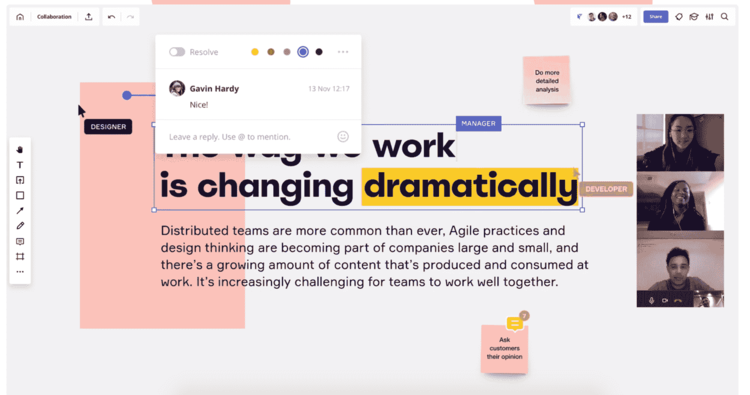
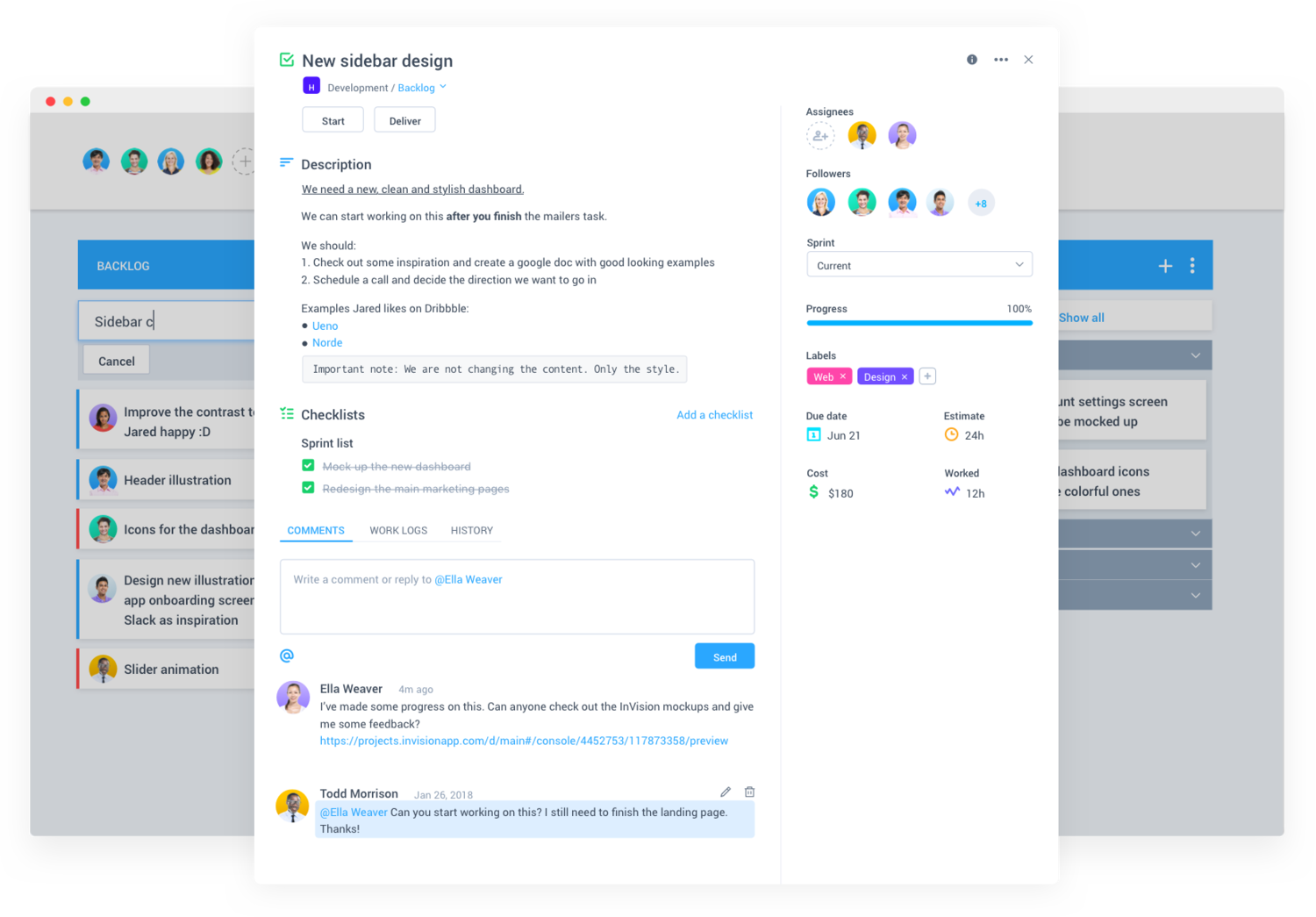
If you’re still communicating with your teammates and keeping track of project updates via email, you’re doing it wrong. Hubstaff Tasks is a project management platform that lets you easily organize your tasks and projects and streamline collaboration with your teammates. You can move tasks to different project phases by dragging and dropping, prioritize tasks more easily, and automate project workflows.
Team collaboration isn’t always easy. It can be difficult to work with certain team members or feel ineffective at times. As Aytekin Tank explains, to both foster effective collaboration and eliminate unnecessary collaboration “make it easier for people to act autonomously by encouraging all staff to leverage resource-sharing technologies.” By combining the right tools, you can begin to set your team up for success to help them do better work.
Learn more about the Cloverleaf integrations here to have more engaged and cohesive teams.


